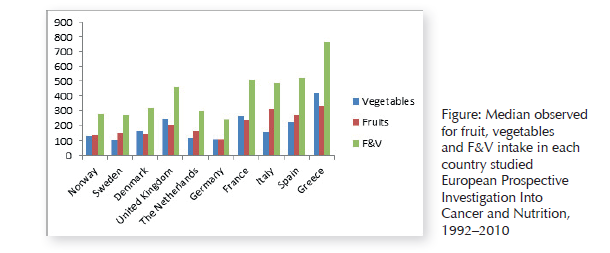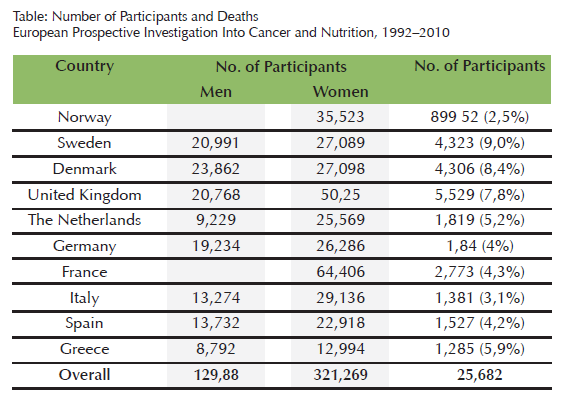A diet rich in fruits and vegetables reduces mortality Study from EPIC
The large size of European Prospective Investigation Into Cancer and Nutrition (EPIC) cohort, combined with its long follow-up, the large number of deaths, and wide range of fruit and vegetable consumption provides an ideal setting to this study.
The cohort included 451,151 participants from 10 European countries, aged 25-70 years. The participants had no history of non-communicable disease (cancer, stroke, diabetes) and were recruited between 1992 and 2000 and followed until 2010.
This study focuses on consumption of total fruits (fresh fruits, dried or canned fruits), total vegetables and fruit and vegetable (F&V) combined. Legumes, potatoes, and other tubers were not included as vegetables. Consumption of F&V juices was excluded because these differ nutritionally (e.g. – added sugars and vitamins).
The aim of this study is:
- To investigate the association of F&V consumption with mortality of all causes, cancer, and cardiovascular disease within the EPIC.
- To estimate the time period by which the risk of death was postponed among participants with a high consumption of fruits and vegetables.
Associations with mortality for vegetables has also been compared according to preparation (i.e. cooked versus raw).Hazard ratios, rate advancement periods, and preventable proportions to respectively compare risk of death between quartiles of consumption, to estimate the period by which the risk of death was postponed among high consumers, and to estimate proportions of deaths that could be prevented if all participants would shift their consumption one quartile upward.
Additional support to the evidence that F&V consumption is associated with a lower risk of death
Median observed of F&V intake in Europe – 387.9 g/day
In the total study population, the observed median value consumption of fruits and vegetables combined was 387.9 g/day and seemed to increase according to a North-to-South gradient.

Older participants, women, and never smokers consumed more F&V than others
Parallel to a high consumption of fruits and vegetables, participants seemed to consume less processed meat and alcohol.
A higher consumption of F&V combined was inversely associated with allcause mortality
An 11% lower risk of death was found for the highest quartile of fruit and vegetable consumption (>569 g/day) when compared with the lowest (<249g/day), and have the risk of death postponed by 1.12 years. For every 200-g/day higher intake of F&V combined, the risk of death was 3-6% lower. The fully adjusted model with spline terms for combined consumption of F&V showed a threshold around 400 g/day of consumption, after which the risk of death did not decrease further.
F&V intake inversely associated with cardiovascular disease mortality
F&V intake were inversely associated with cardiovascular disease mortality, rate advancement period of 1.37, and preventable proportion of 4.24%. However, no clear inverse association with cancer mortality was observed. It should be noted that the lack of signifi cant inverse associations for cancer mortality may be explained by the longer induction periods that exist for cancers than for cardiovascular disease.
Fruit consumption was inversely associated with risk of death for women
All participants with high fruit consumption had slightly lower risk of death when analyzed overall, but after stratifi cation by gender, the association was observed only in women. The preventable proportion for women was 2.13%. Vegetable consumption was inversely associated with risk of death for all The risk of death was inversely associated with vegetable consumption, with a hazard ratio of 0.90 and a rate advancement period of 1.17 for participants in the highest versus the lowest quartile (>312.1 vs. <106.8 g/day). No notable differences between genders were observed. Mortality was 3%–5% lower for every 100-g/day higher intake of vegetables.
A stronger inverse association for raw vegetable than for cooked vegetable
When stratifying vegetable consumption by mode of preparation, a stronger inverse associations in the highest quartile was observed for raw vegetables than for cooked vegetables for all-cause, CVD and cancer mortality. Additionally, no threshold appeared in the inverse association between raw vegetables and all-cause mortality. The relation between raw vegetables and a lower risk of death has been observed previously. Possible mechanisms by which cooking affects the association between vegetables and mortality include changes in the availability of nutrients, destruction of digestive enzymes, and alteration of the structure and digestibility of vegetables.
Stronger inverse associations for participants with high alcohol consumption or high body mass index
The inverse association between fruit and vegetable consumption and mortality seemed stronger for participants with a body mass index over 30 and participants with high alcohol consumption (>30 g/day in women and >60 g/day in men) and was suggested for smokers. This seems consistent with the antioxidant properties of fruits and vegetables, as a higher alcohol consumption, a higher body mass index, and smoking all have been shown to increase oxidative stress. However, residual confounding cannot be excluded here, because participants that consume more fruits and vegetables may be healthier considering factors that were not included in the analysis.

